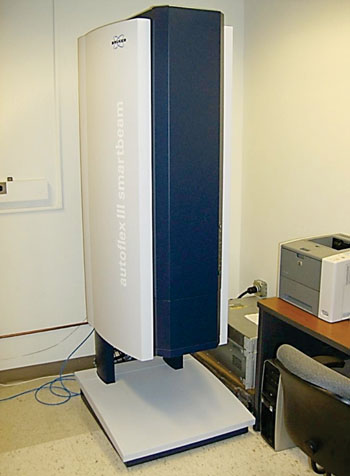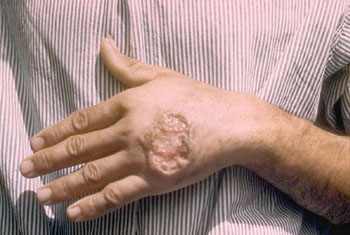Cutaneous Leishmaniasis Species Identified by Mass Spectrometry
|
By LabMedica International staff writers Posted on 18 Jun 2014 |

Image: The BrukerAutoflex MALDI-TOF mass spectrometer (Photo courtesy of Bruker-Daltonics).

Image: Cutaneous Leishmaniasis lesion on the hand (Photo courtesy of D.S. Martin).
Cutaneous leishmaniasis (CL) is caused by several Leishmania species that are associated with variable outcomes before and after therapy and optimal treatment decision is based on an accurate identification of the infecting species.
Current methods to type Leishmania isolates are relatively complex and slow and therefore, the initial treatment decision is generally presumptive, the infecting species being suspected on epidemiological and clinical grounds. A simple method to type cultured isolates would facilitate disease management.
Scientists at the University Pierre et Marie Curie (Paris, France) performed parasitological diagnosis and analysis by lesion scraping, biopsy or aspirate followed by direct examination of Giemsa-stained smears, histological analysis, Giemsa-stained tissue sections, culture or polymerase chain reaction (PCR). They also analyzed promastigote pellets from 46 strains cultured in monophasic medium, including 20 short-term cultured isolates from French travelers, 19 with CL, and one with visceral leishmaniasis and clinical isolates were analyzed in parallel with Multilocus Sequence Typing (MLST).
The promastigote pellets were analyzed by Matrix Assisted Laser Desorption Ionization Time-of-Flight (MALDI-TOF) technology and performed on a BrukerAutoflex I MALDI-TOF mass spectrometer (Bruker-Daltonics, Bremen, Germany). Automatic dendrogram analysis generated a classification of isolates consistent with reference determination of species based on MLST or 70 kDa heat shock protein gene (hsp70) sequencing. An analysis of the spectra, based on a very simple, database-independent analysis of spectra, showed that the mutually exclusive presence of two pairs of peaks discriminated isolates considered by reference methods to belong either to the Viannia or Leishmania subgenus, and that within each subgenus presence or absence of a few peaks allowed discrimination to species complexes level.
The authors concluded that analysis of cultured Leishmania isolates using mass spectrometry allows a rapid and simple classification to the species complex level consistent with reference methods, a potentially useful method to guide treatment decision in patients with cutaneous leishmaniasis. The intuitive interpretation of spectra was well-suited for allowing for close interactions between parasitologists and clinicians. The study was published on June 5, 2014, in the journal Public Library of Science Neglected Tropical Diseases.
Related Links:
University Pierre et Marie Curie
Bruker-Daltonics
Current methods to type Leishmania isolates are relatively complex and slow and therefore, the initial treatment decision is generally presumptive, the infecting species being suspected on epidemiological and clinical grounds. A simple method to type cultured isolates would facilitate disease management.
Scientists at the University Pierre et Marie Curie (Paris, France) performed parasitological diagnosis and analysis by lesion scraping, biopsy or aspirate followed by direct examination of Giemsa-stained smears, histological analysis, Giemsa-stained tissue sections, culture or polymerase chain reaction (PCR). They also analyzed promastigote pellets from 46 strains cultured in monophasic medium, including 20 short-term cultured isolates from French travelers, 19 with CL, and one with visceral leishmaniasis and clinical isolates were analyzed in parallel with Multilocus Sequence Typing (MLST).
The promastigote pellets were analyzed by Matrix Assisted Laser Desorption Ionization Time-of-Flight (MALDI-TOF) technology and performed on a BrukerAutoflex I MALDI-TOF mass spectrometer (Bruker-Daltonics, Bremen, Germany). Automatic dendrogram analysis generated a classification of isolates consistent with reference determination of species based on MLST or 70 kDa heat shock protein gene (hsp70) sequencing. An analysis of the spectra, based on a very simple, database-independent analysis of spectra, showed that the mutually exclusive presence of two pairs of peaks discriminated isolates considered by reference methods to belong either to the Viannia or Leishmania subgenus, and that within each subgenus presence or absence of a few peaks allowed discrimination to species complexes level.
The authors concluded that analysis of cultured Leishmania isolates using mass spectrometry allows a rapid and simple classification to the species complex level consistent with reference methods, a potentially useful method to guide treatment decision in patients with cutaneous leishmaniasis. The intuitive interpretation of spectra was well-suited for allowing for close interactions between parasitologists and clinicians. The study was published on June 5, 2014, in the journal Public Library of Science Neglected Tropical Diseases.
Related Links:
University Pierre et Marie Curie
Bruker-Daltonics
Latest Clinical Chem. News
- 3D Printed Point-Of-Care Mass Spectrometer Outperforms State-Of-The-Art Models
- POC Biomedical Test Spins Water Droplet Using Sound Waves for Cancer Detection
- Highly Reliable Cell-Based Assay Enables Accurate Diagnosis of Endocrine Diseases
- New Blood Testing Method Detects Potent Opioids in Under Three Minutes
- Wireless Hepatitis B Test Kit Completes Screening and Data Collection in One Step
- Pain-Free, Low-Cost, Sensitive, Radiation-Free Device Detects Breast Cancer in Urine
- Spit Test Detects Breast Cancer in Five Seconds
- Electrochemical Sensors with Next-Generation Coating Advances Precision Diagnostics at POC
- First-Of-Its-Kind Handheld Device Accurately Detects Fentanyl in Urine within Seconds
- New Fluorescent Sensor Array Lights up Alzheimer’s-Related Proteins for Earlier Detection
- Automated Mass Spectrometry-Based Clinical Analyzer Could Transform Lab Testing
- Highly Sensitive pH Sensor to Aid Detection of Cancers and Vector-Borne Viruses
- Non-Invasive Sensor Monitors Changes in Saliva Compositions to Rapidly Diagnose Diabetes
- Breakthrough Immunoassays to Aid in Risk Assessment of Preeclampsia
- Urine Test for Monitoring Changes in Kidney Health Markers Can Predict New-Onset Heart Failure
- AACC Releases Comprehensive Diabetes Testing Guidelines
Channels
Clinical Chemistry
view channel
3D Printed Point-Of-Care Mass Spectrometer Outperforms State-Of-The-Art Models
Mass spectrometry is a precise technique for identifying the chemical components of a sample and has significant potential for monitoring chronic illness health states, such as measuring hormone levels... Read more.jpg)
POC Biomedical Test Spins Water Droplet Using Sound Waves for Cancer Detection
Exosomes, tiny cellular bioparticles carrying a specific set of proteins, lipids, and genetic materials, play a crucial role in cell communication and hold promise for non-invasive diagnostics.... Read more
Highly Reliable Cell-Based Assay Enables Accurate Diagnosis of Endocrine Diseases
The conventional methods for measuring free cortisol, the body's stress hormone, from blood or saliva are quite demanding and require sample processing. The most common method, therefore, involves collecting... Read moreMolecular Diagnostics
view channelBlood Proteins Could Warn of Cancer Seven Years before Diagnosis
Two studies have identified proteins in the blood that could potentially alert individuals to the presence of cancer more than seven years before the disease is clinically diagnosed. Researchers found... Read moreUltrasound-Aided Blood Testing Detects Cancer Biomarkers from Cells
Ultrasound imaging serves as a noninvasive method to locate and monitor cancerous tumors effectively. However, crucial details about the cancer, such as the specific types of cells and genetic mutations... Read moreHematology
view channel
Next Generation Instrument Screens for Hemoglobin Disorders in Newborns
Hemoglobinopathies, the most widespread inherited conditions globally, affect about 7% of the population as carriers, with 2.7% of newborns being born with these conditions. The spectrum of clinical manifestations... Read more
First 4-in-1 Nucleic Acid Test for Arbovirus Screening to Reduce Risk of Transfusion-Transmitted Infections
Arboviruses represent an emerging global health threat, exacerbated by climate change and increased international travel that is facilitating their spread across new regions. Chikungunya, dengue, West... Read more
POC Finger-Prick Blood Test Determines Risk of Neutropenic Sepsis in Patients Undergoing Chemotherapy
Neutropenia, a decrease in neutrophils (a type of white blood cell crucial for fighting infections), is a frequent side effect of certain cancer treatments. This condition elevates the risk of infections,... Read more
First Affordable and Rapid Test for Beta Thalassemia Demonstrates 99% Diagnostic Accuracy
Hemoglobin disorders rank as some of the most prevalent monogenic diseases globally. Among various hemoglobin disorders, beta thalassemia, a hereditary blood disorder, affects about 1.5% of the world's... Read moreImmunology
view channel.jpg)
AI Predicts Tumor-Killing Cells with High Accuracy
Cellular immunotherapy involves extracting immune cells from a patient's tumor, potentially enhancing their cancer-fighting capabilities through engineering, and then expanding and reintroducing them into the body.... Read more
Diagnostic Blood Test for Cellular Rejection after Organ Transplant Could Replace Surgical Biopsies
Transplanted organs constantly face the risk of being rejected by the recipient's immune system which differentiates self from non-self using T cells and B cells. T cells are commonly associated with acute... Read more
AI Tool Precisely Matches Cancer Drugs to Patients Using Information from Each Tumor Cell
Current strategies for matching cancer patients with specific treatments often depend on bulk sequencing of tumor DNA and RNA, which provides an average profile from all cells within a tumor sample.... Read more
Genetic Testing Combined With Personalized Drug Screening On Tumor Samples to Revolutionize Cancer Treatment
Cancer treatment typically adheres to a standard of care—established, statistically validated regimens that are effective for the majority of patients. However, the disease’s inherent variability means... Read morePathology
view channelHyperspectral Dark-Field Microscopy Enables Rapid and Accurate Identification of Cancerous Tissues
Breast cancer remains a major cause of cancer-related mortality among women. Breast-conserving surgery (BCS), also known as lumpectomy, is the removal of the cancerous lump and a small margin of surrounding tissue.... Read more
AI Advancements Enable Leap into 3D Pathology
Human tissue is complex, intricate, and naturally three-dimensional. However, the thin two-dimensional tissue slices commonly used by pathologists to diagnose diseases provide only a limited view of the... Read more
New Blood Test Device Modeled on Leeches to Help Diagnose Malaria
Many individuals have a fear of needles, making the experience of having blood drawn from their arm particularly distressing. An alternative method involves taking blood from the fingertip or earlobe,... Read more
Robotic Blood Drawing Device to Revolutionize Sample Collection for Diagnostic Testing
Blood drawing is performed billions of times each year worldwide, playing a critical role in diagnostic procedures. Despite its importance, clinical laboratories are dealing with significant staff shortages,... Read moreTechnology
view channel
New Diagnostic System Achieves PCR Testing Accuracy
While PCR tests are the gold standard of accuracy for virology testing, they come with limitations such as complexity, the need for skilled lab operators, and longer result times. They also require complex... Read more
DNA Biosensor Enables Early Diagnosis of Cervical Cancer
Molybdenum disulfide (MoS2), recognized for its potential to form two-dimensional nanosheets like graphene, is a material that's increasingly catching the eye of the scientific community.... Read more
Self-Heating Microfluidic Devices Can Detect Diseases in Tiny Blood or Fluid Samples
Microfluidics, which are miniature devices that control the flow of liquids and facilitate chemical reactions, play a key role in disease detection from small samples of blood or other fluids.... Read more
Breakthrough in Diagnostic Technology Could Make On-The-Spot Testing Widely Accessible
Home testing gained significant importance during the COVID-19 pandemic, yet the availability of rapid tests is limited, and most of them can only drive one liquid across the strip, leading to continued... Read moreIndustry
view channel
Danaher and Johns Hopkins University Collaborate to Improve Neurological Diagnosis
Unlike severe traumatic brain injury (TBI), mild TBI often does not show clear correlations with abnormalities detected through head computed tomography (CT) scans. Consequently, there is a pressing need... Read more
Beckman Coulter and MeMed Expand Host Immune Response Diagnostics Partnership
Beckman Coulter Diagnostics (Brea, CA, USA) and MeMed BV (Haifa, Israel) have expanded their host immune response diagnostics partnership. Beckman Coulter is now an authorized distributor of the MeMed... Read more_1.jpg)












_1.jpg)
.jpg)
